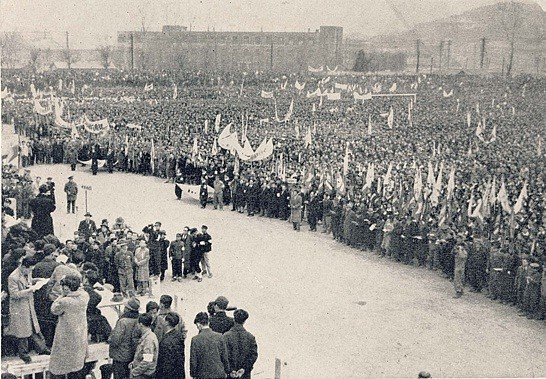(Korean War) Korean Divison 1945 - 1948, Post # 16
Prof. Kathryn Weathersby

At the same time Soviet authorities in the North instructed the Korean Communist Party in the South to support the Moscow Conference decision on trusteeship, they also took steps to ensure support for the agreement in their zone. They published it in newspapers and distributed it as a pamphlet. Most importantly, they called a meeting of the Five Provinces Temporary People’s Committee for January 4, making sure this body would endorse the Moscow Conference agreement by arranging that most of the nationalist members would be absent.
The Soviet officers and communist party leaders were not able, however, to persuade Cho Man-sik to support trusteeship. The venerable nationalist leader refused all their appeals to remain in his post as head of the Committee. Instead, he protested the rigged vote of January 4 by resigning his position. Then, since he was no longer useful as a token to demonstrate cooperation with centrist parties, Soviet authorities placed him under house arrest. Most of his followers fled to Seoul, fearing for their own safety.
Acting quickly to head off popular opposition to trusteeship, Shtykov’s men organized a mass demonstration in Pyongyang on January 6 to declare support for the Moscow Conference decision. According to a press account they sent to Moscow for publication in Soviet newspapers, the 100,000 participants carried flags of Korea, the USSR, the USA, Great Britain, and China, along with portraits of Lenin, Stalin, and Kim Il Sung, and banners expressing not only full approval of the decision on trusteeship but also the Korean people’s gratitude to their liberators, the Red Army, and its leader, Generalissimo Stalin. “The decision of the Moscow conference of Three Ministers will secure the freedom, independence, and construction of democracy in Korea,” the banners proclaimed.
Having neutralized opposition to the agreement in the North, the Soviets began a campaign to define all non-communist leaders in the South as anti-democratic as a way to disqualify them from participation in the formation of the new national government. On January 12 the main newspaper of the Communist Party of the Soviet Union, Izvestiia, denounced Syngman Rhee, Kim Koo, and their followers as reactionaries and pro-Japanese collaborators for opposing the Moscow agreement, which it extolled as marking a “new era in the history of Korea.”
Cho Man-sik’s followers were right to fear for their safety. In late December, a high-ranking Soviet official, the Chief of the Political Administration of the Soviet Armed Forces, personally examined the political situation within the Soviet zone in Korea. He reported to Molotov that the economic domination of landlords in the villages had seriously impeded the further democratic transformation of Korea and had prevented the growth of the political activity of the masses. In Soviet discourse, “democratic” meant not political democracy, as the word was used in the West, but social democracy of a Marxist sort. In other words, “democratic” meant pro-communist if not outright communist. Shikin concluded that it was necessary to centralize power and transfer it into the hands of Korean “democratic” figures, as Moscow defined the term.
This goal naturally required that appropriately loyal persons be identified and trained. Shikin recommended that Soviet personnel find Koreans with a friendly attitude toward the USSR. These people could strengthen the Soviet Union’s political position in Korea and set right its economic and political life. He also urged the Soviet authorities in the North to carry out land reform as soon as possible.
In fact, Soviet officers had already begun training loyal cadres. In November 1945 they established a political school in Pyongyang to prepare administrators and technicians. This was an urgent need since they had barred most educated persons from holding responsible positions. Half of the eight departments of the school prepared cadres for police work, suggesting how pressing a need they had to maintain order. The other half prepared Koreans for positions in party, government, and social organizations – groups such as peasants’ league, youth league, or women’s league. Students followed a course of study made up of 160 hours of history of the Bolshevik party, 600 hours of party building, 140 hours of history of Korea and of the Korean national liberation movement, 150 hours of present policy, 150 hours of economic and political geography of the world, and 70 hours of Russian language study. By April 1946, 500 students had completed this course of study and 1370 others were enrolled.
In the next post we will examine how the Soviet authorities and Korean communists moved quickly to secure economic and political control over their half of Korea before the Joint Commission could do its work. They accomplished this task by sealing the border with the South and carrying out land reform.
[Sources: Russian State Archive of Social-Political History, Fond 17, Opis 128, Delo 205, Listy 2-4; Scalapino and Lee, The Korean Communist Movement, Part I; Joungwoon A. Kim, “Soviet Policy in North Korea,” World Politics Vol. 22, No. 2 (January 1970); Archive of the Foreign Policy of the Russian Federation, Fond 18, Opis 8, Delo 78, Papka 6, List 2; Jeon Hyun Soo, “Sotsial’no-ekonomicheskie preobrazovaniia v severnoi Koree v pervye gody posle osvobozhdeniia, 1945-1948” (Social-Economic Transformation in North Korea in the First Years after Liberation) Ph.D. Dissertation, Moscow State University, 1997]
Go here https://steemit.com/@a-a-a to get your post resteemed to over 72,000 followers.
To listen to the audio version of this article click on the play image.

Brought to you by @tts. If you find it useful please consider upvoting this reply.